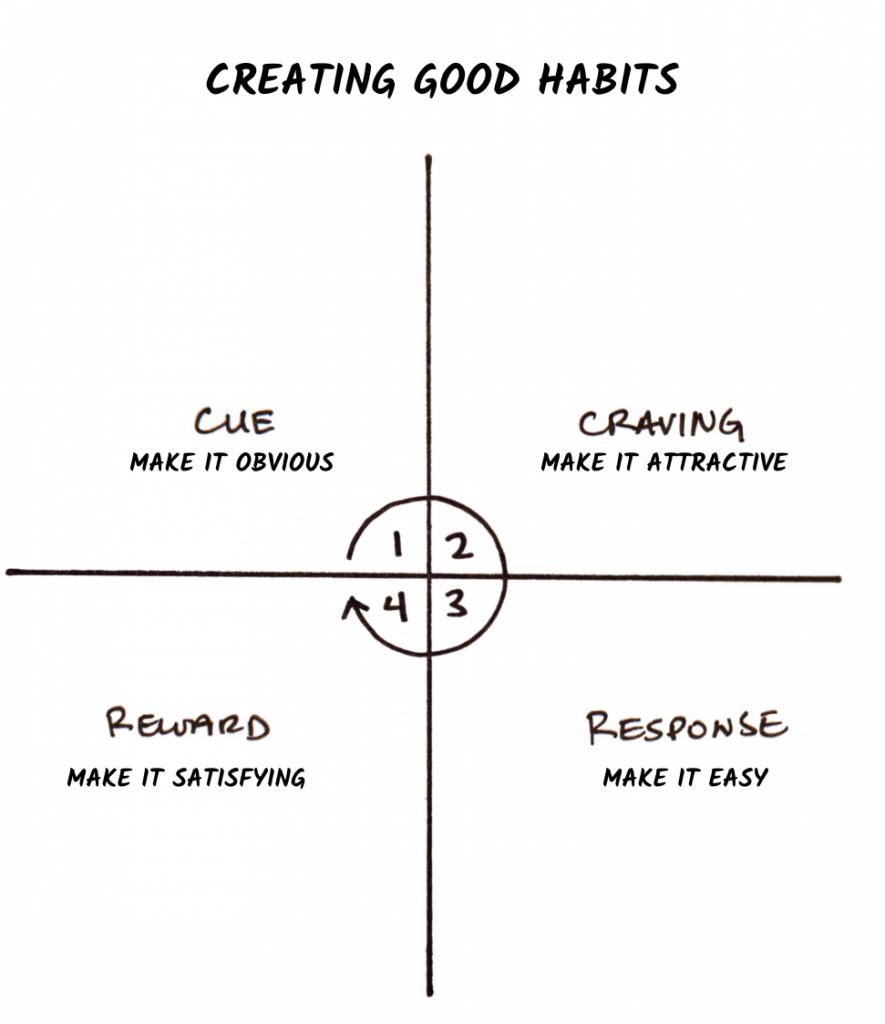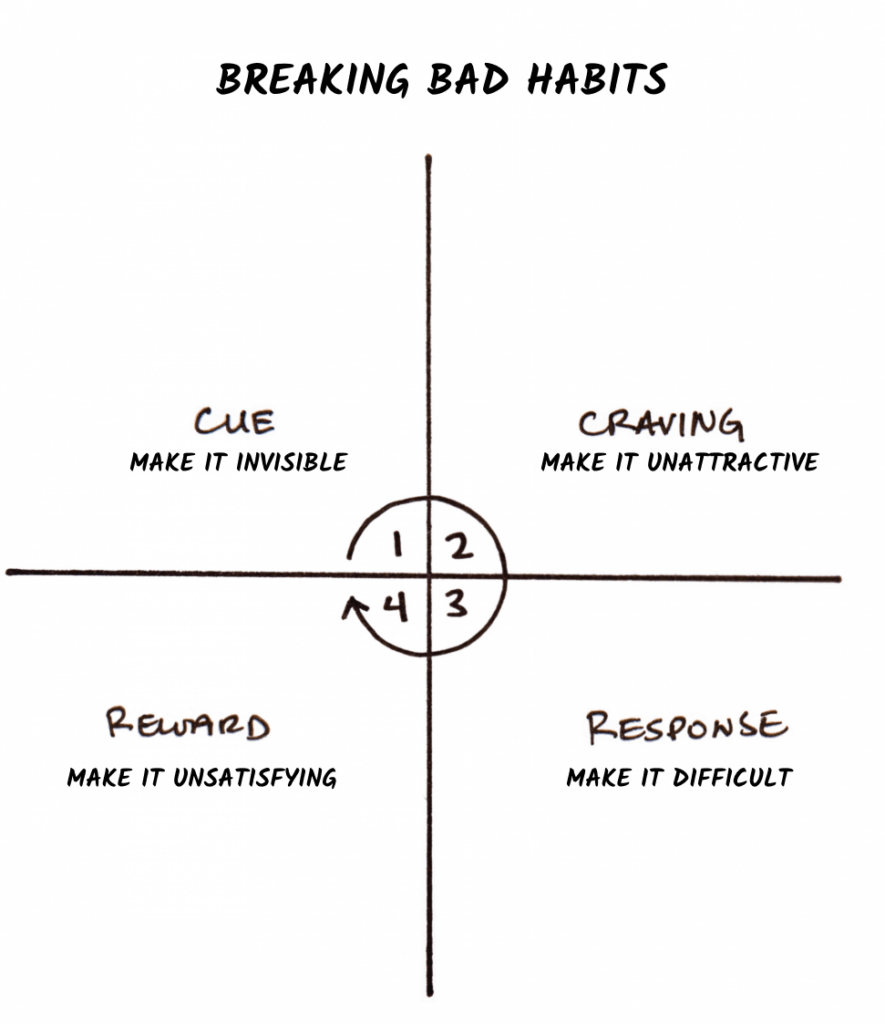Have you heard about the book Atomic Habits? It’s one of the most popular self-improvement books in the world, often ranking as the number one title on Amazon across several different categories. It’s written to help you change your daily habits. To follow the methods outlined in the book, the author recommends using accountability to help you quickly and easily adopt good habits. One chapter is even titled:
“How an Accountability Partner Can Change Everything”
Research has shown that people are 55% more likely to achieve their goals when regularly reporting their progress to a third party. This article is about integrating both atomic habits and accountability into your routine to help you transform your life.
In this article, we will discuss:

Brief Summary of Atomic Habits
The concept of atomic habits comes from the book written by James Clear, which has sold over twenty million copies worldwide and is currently, at the time of this writing, the #1 non-fiction book on Amazon. In this mega-popular book on habit change, the author details how to create small, tiny habits that help you change your behavior. Clear emphasizes that often it is not the individual’s lack of willpower but the wrong system that hinders positive behavior change. As you start to normalize these smaller habits into your routine, you slowly start to expand on them by increasing the time or effort you spend on those habits. Eventually, you’ll cultivate more habits that support your new identity.
Identity and one percent growth are two key concepts within the book. Clear states that our habits help to form and reinforce our identity, so when we try to accomplish too much at once, we face internal resistance. We tell ourselves, “This isn’t who I am, but I’m forcing myself to do it.” Instead, the goal is to think, “This is who I am, and that’s why I’m doing it.” You reinforce this new identity by creating new habits that that new identity would have. For example, if you want to become a “fit person,” you begin by adopting small habits that a fit person would engage in, such as taking the stairs instead of the elevator or drinking more water. This gradual shift helps you internalize the new behavior as part of who you are, making it easier to sustain. This mental change takes time, but creating good habits are fundamental in achieving lasting change and self improvement.
Clear’s concept of one percent growth helps to make habit formation easier. He suggests trying to improve yourself by one percent per day, which seems small and less threatening to our current identity. Making the new habit small is important because it allows us to overcome mental resistance. While one percent seems almost insignificant, if you focus on continuous improvement and you’re successful at improving one percent a day in a year, you will actually be thirty-seven times better than you were when you started.
What are atomic habits?
Creating good habits is not easy. Sometimes, it takes a little more than just having a habit tracker on your phone. Atomic habits are small, incremental changes that compound over time to create significant transformations. The term “atomic” refers to both the tiny nature of these habits and their potential to serve as fundamental building blocks for larger lifestyle changes. These tiny, good habits are deliberately designed to be so effortless that they eliminate internal resistance, making habit formation easier to sustain.
Unlike major lifestyle overhauls, which often require substantial effort and willpower, atomic habits fit seamlessly into your daily life. By making a good habit so small that it feels almost effortless, you reduce the mental friction that often leads to failure. For example, rather than committing to a daily hour-long workout, you could start with a single push-up or a two-minute stretch. Over time, these small actions grow into more substantial behaviors.
The power of atomic habits lies in their compounding effect. By improving just one percent each day, these small changes accumulate into massive transformations over time that compound like interest. A single positive habit might seem insignificant in the short term, but its impact multiplies exponentially as it becomes ingrained in your routine.By focusing on small, consistent improvement, you can develop good habits, eliminate bad habits, and create lasting changes in your life, but how exactly do you do that? Atomic Habits recommends four laws of behavior change.
The Four Laws of Behavior Change according to Atomic Habits
Habit formation is crucial in living up to your potential. Following the four laws of behavior change makes making good habits inevitable. Here, we list the key takeaways from each law.
Creating Good Habits
To create a good habit, Clear suggests that you make it as easy as possible to perform. Here are the four suggestions he recommends when thinking about how to add a new habit into your life:

Make it obvious with habit stacking
In order to perform a particular habit more consistently, Clear recommends creating cues in your environment to make sure that the habit is always visible. The more visible it is, the more you remember it, think about it, and continue to do it.
This looks different for different habits. If you want to save for something particular, for example, you could place a savings jar on your coffee table. If you want to read more, you could set a book on your bed stand. If you want to eat better, you could add a fruit bowl at the center of your countertop. One place that is often visible to us is our phone screensaver. Your phone screensaver can be a constant reminder of what you’re trying to change in your life.
Another not so obvious cue in your environment is time. You could set a specific time for when you want to do a task. Choosing a time when you generally have nothing else going on is a good way to commit to a task. Setting an alarm can be a helpful reminder. This is especially useful when trying to change your eating or sleep schedule, as your body will start to become accustomed to these new patterns within a couple of weeks.
Another effective cue can be a current habit that you’re already performing. Once you identify your current habits that you perform daily, you can use them as foundations for integrating new behaviors. This concept is known as habit stacking. Some examples of habit stacking include:
There are multiple different habits in your life that you can attach good habits to just by using habit stacking.
Make it attractive
Another way to help you stay consistent is to make the habit attractive. One method that Clear suggests is temptation bundling, which involves adding something enjoyable to your habit to make it something you look forward to doing. Examples of this include watching television while using the stationary bike or elliptical, running in the park on a beautiful day, listening to music while you clean, enjoying a bubble bath while studying or reading, or having your favorite drink at a local cafe when working on a personal project.
Make it easy
Clear advises focusing on the number of times that the habit is performed, not how much we perform while doing the habit. Performing and showing up is the most important aspect. When trying to build a new habit, he suggests committing to doing it for a short amount of time like two minutes. While two minutes may seem too little, once you commit to just those two minutes per day, you often find that you end up doing more than those two minutes. Making the habit as simple and easy as possible is key.
If you can automate the habit, even better. Want better sleep? Add black out curtains to your room or invest in a better mattress. Want to limit distractions? Keep your phone on silent mode. Want to eat better? Use smaller plates to decrease portion size. Want to save more? Automatically transfer money to a bank account that you don’t regularly check.
Make it satisfying
If you want to make a habit more satisfying, it’s best to try to create some kind of immediate reward that happens when you perform it. Behaviors are often repeated if they are immediately rewarded, so when trying to change your eating habits, focus on the foods you can eat that taste well. If you’re trying to save for a vacation, add a glass jar in your home to see the money grow as you save. If you don’t use cash, you can use a savings account nicknamed “Vacation Fund,” and every time you skip out on your morning latte from Starbucks, you can transfer that same amount to the savings account.
When working on a project and you have a to-do list, also create a “done” list. When you finish things, add them to your done list and watch it grow and grow, or you can use an application to track how many times you perform a habit.
Breaking Bad Habits
It would be amazing if we could make bad habits impossible, but just like habit formation can be difficult, breaking a bad habit can be just as challenging. Bad habits repeat in our lives until we can break them. Using the inverse of the four laws of behavior change for building good habits can make it easier to break habits.

Make it invisible
If you can’t make bad habits impossible, then you can at least make them invisible. Do your best to remove the temptation. For example, if you want to eat healthier, remove junk food from your home.Want to use your phone less? Place it in a drawer when you’re not using it. Want to watch less television? Consider moving the TV out of your bedroom.
Make it unattractive
Breaking a bad habit can be challenging, especially if we focus on what it brings into our life. Instead, try to highlight the positive benefits of not engaging in the bad habit and the negative consequences of continuing it.
For example, if you’re quitting nicotine, ask yourself questions. Can you breathe better? Is your skin better? Are you saving money? On the other hand, think about how smoking makes you smell worse or causes you to wake up with phlegm in your throat. If you’re aiming to quit drinking or smoking weed, will you save more money, get more done, or feel freer to enjoy more activities if you succeed? When you actually drink or smoke, notice how drinking or smoking may leave you feeling unproductive or physically sluggish.
Similarly, if you’re working on improving your eating habits, ask yourself if avoiding heavy foods leaves you feeling more in control, energized, and possibly leaner. Meanwhile, when indulging in those heavy foods, think about how it causes you feelings of lethargy, weight gain, or bloating. Write down these positives and negatives and post them for when you’re feeling weak. Reflecting on them can help make the bad habit less appealing and keep you focused on the benefits of quitting.
Make it difficult
If you can’t completely remove an item from your environment, make it harder to access by putting it out of reach, like in a tall cabinet that can only be reached with a stepping stool that is also placed in a different room. This can work with your phone when you’re trying to focus on work, studying, or a passion project. It can also work with foods you’re trying to avoid. If you’re trying to avoid different websites or applications, you can disconnect from the internet or use app and website blocking applications. Similarly, if you want to save more money, delete shopping apps from your phone or leave your credit cards and cash at home.
Make it unsatisfying
In order to make a habit unsatisfying, you can commit publicly to stopping it. The negative feelings of failing in front of others can create social pressure to follow through. You could also tell a buddy that you’ll join them for a workout or study session at a specific time, making it much more difficult to skip out on those activities. There are also additional sites online where you can pledge your money to follow through with an action, and without submitting proof of that action in forms of a picture, you lose your pledge.

How to incorporate accountability into your atomic habits?
Friends and Family
Clear mentions the power of social cost or the idea of looking bad in front of others. Telling a friend or family member that you’re going to start or stop a habit can help create a social cost when you don’t follow through. What will they say about me? Will I disappoint them?
This can be helpful, but many times, our family and friends are busy with their own day-to-day lives and can be more understanding when we slip up. This can lead to them being less invested in our success and decrease the social cost. Even worse, this can subconsciously sabotage us when we’re trying to improve. We could project ourselves onto them by saying to ourselves, “If they’re not trying to improve, why should I?”
Apps – Habit Tracker
An application like a habit tracker can be a great way to track habit progress and create a satisfying habit streak. It’s also a convenient way to monitor progress and see where you’re improving, which can be quite encouraging. However, apps don’t create the same social cost as a real person. Letting down the owl from Duolingo is a little less motivating than letting down an actual person.
Find a Mentor
A mentor is one of the best ways to help you achieve a goal, and reporting to a mentor can make a habit more satisfying. They can lay out the steps you need to take, show you your blind spots, and tell you what to expect in the future. While a mentor may not directly help you build habits, they are definitely a cheat sheet to success in most goals you’re trying to achieve. However, in general, it is very difficult to find a mentor who has walked your same path, cares about your success, and has the availability to assist you when you need it.
Join a group
If you’re generally a social person, joining a group dedicated to the habit you want to build can make it more attractive. This could be a beginner’s lesson, a local gym class, an online community, or a club. Finding a friend, or maybe even a crush, within the group can help encourage you to show up and participate more often.
Social Media
You can also simply announce what you’re going to do to your friends or followers on social media. You can make videos or pictures showing your journey and make it fun. This also increases the social cost of not succeeding, and if you’re really lucky, maybe you can become a social media influencer and get free stuff, although this is probably not the best reason to commit to it. Still, not everyone wants to share their personal journey on the internet. It can be scary, and some people simply hate social media.
Accountability Partner
Another way to incorporate accountability into your life is to get an accountability partner. This person can also be a friend or family member, but there’s a more formal agreement between the two of you, and they’re generally more invested in your success. Clear mentions that creating a habit contract between another person makes it difficult not to follow through, stating that “knowing that someone is watching can be a powerful motivator.”

How do I implement atomic habits and accountability to help me get closer to my goals?
Besides what’s mentioned in Atomic Habits, you can also incorporate accountability to help you maintain a good habit and get closer to your goals. Habits shape one’s identity and can lead to significant personal growth when systematically changed.
Make it obvious
If you want to make a habit more obvious, you can have your partner send you check-in messages. These messages can pop up right when you plan to do a task and can be followed up when you plan to end a task. They can also call you up and tell you to perform a task, though this might be a bit more extreme. At Habit Companion, we’ve implemented both practices and have found that check-in messages tend to be better because their light nudges in your environment. Phone calls sound better, but in the long run, when implemented incorrectly, tend to be worse and can cause negative feelings between the person performing the habit and the caller.
Make it attractive
A good way of making a habit more attractive is being able to tell your partner that you were successful. It feels like you’re making someone else proud of you, and if that person is really committed to your success, you’ll feel good about it as well. If the habit you’re trying to build is unattractive, a good partner can help you brainstorm ways to make the habit more attractive and more pleasurable.
Make it easy
Another great thing about having a third person monitoring your behavior is having an external perspective on your situation. Maybe you’re committing too much, and it’s exhausting you, or maybe you’re performing a habit at a time when it’s not optimal for you. Having that second set of eyes can help you look for ways to make the habit more manageable. Your partner can help you brainstorm different ways to make the habit seem easier. They can help you break down bigger tasks so you have smaller but more consistent wins. They can suggest ways to automate a habit or make it more convenient for you.
Make it satisfying
Finally, there’s something really satisfying about telling someone that you’ve been successful and consistent. There are different ways to let them know, but you can send photos and screenshots or have a call with them just so you can brag. Don’t be bashful. If you’re doing great, you deserve it, and if they’re a really great partner, they will be cheering you on and congratulating you as if they had succeeded themselves.

Final Summary
Atomic Habits is one of the most popular books in the world for its real and practical steps that it uses to help people make good habits and bread bad habits through small, incremental steps. To develop good habits, it’s good to follow the four laws of behavior change: make it obvious, attractive, easy, and satisfying. The keys to breaking a habit are to make a habit invisible, unattractive, difficult, and unsatisfying. You can use different forms of accountability to help you succeed, like a habit tracker or a mentor. One of the best forms of accountability that can help you change your behavior is getting an accountability partner. A good partner can make a habit more obvious, attractive, easy, and satisfying with less work on your part, and it can be more fun! Changing your habits can be difficult, but starting small and recruiting a little bit of help can make it much easier.

